Ivan Mazepa
| Ivan Mazepa Іван Мазепа | |
|---|---|
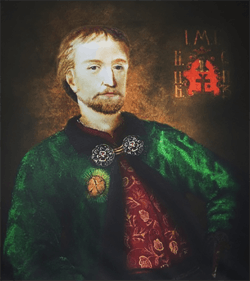 | |
| Hetman of Zaporizhian Host | |
|
In office July 25, 1687 – November 11, 1708 | |
| Preceded by | Ivan Samoylovych |
| Succeeded by | Pylyp Orlyk (hetman in exile) |
| Personal details | |
| Born |
March 30, 1639 (NS) Bila Tserkva, Kiev Voivodeship, Polish-Lithuanian Commonwealth |
| Died |
October 2, 1709 (aged 70) (NS) Bender, Moldavia |
| Nationality | Ruthenian (Ukrainian) |
| Spouse(s) | Hanna Polovets (1642-1704) |
| Religion | Eastern Orthodox (excommunicated from the Russian Orthodox church in 1708) |
| Signature |
 |
| Ivan Mazepa | |
|---|---|
| Coat of arms |
Kurcz Coat of Arms 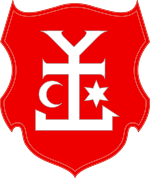 |
| Noble family | Mazepa family |
Ivan Stepanovych Mazepa (Ukrainian: Іван Степанович Мазепа, Polish: Jan Mazepa Kołodyński; March 30 [O.S. March 20] 1639 – October 2 [O.S. September 21] 1709)[1] was the Hetman of Zaporizhian Host in 1687–1708, and is claimed to be awarded a title of Prince of the Holy Roman Empire in 1707 for his efforts for the Holy League.[2] He was famous as a patron of the arts, and also played an important role in the Battle of Poltava where after learning of Peter I's intent to relieve him as acting Hetman of Ukraine and replace him with Alexander Menshikov, he deserted his army and sided with Charles of Sweden. The politicization of this desertion has held a lasting legacy in both Russian and Ukrainian national history.
Because of this, the Russian Orthodox Church has laid an anathema on his name since the beginning of the 18th century and refuses to revoke it to this day. Everyone who opposed the Russian government in eighteenth-century Ukraine were derogatorily referred to as Mazepintsy (Mazepists).[3] The alienation of Mazepa from Ukrainian history continued during the Soviet period, but since Ukraine's independence there have been strong moves to rehabilitate Mazepa's image, although he remains a figure of mixed standing.
Early life
Mazepa was probably born on March 30, 1639,[1] in Mazepyntsi, near Bila Tserkva, then part of the Kiev Voivodeship in the Polish-Lithuanian Commonwealth (today – Drozdy rural council, Bila Tserkva Raion), into a noble Ruthenian-Lithuanian family. His mother was Maryna Mokievska (1624–1707) (known from 1674–75 by her monastic name Maria Magdalena),[4] and his father was Stefan Adam Mazepa (?-1666). Maryna Mokievska came from the family of a Cossack officer who fought alongside Bohdan Khmelnytsky. She gave birth to two children – Ivan and Oleksandra. Stefan Mazepa served as an Otaman of Bila Tserkva (1654), a Cossack representative of the King of the Polish-Lithuanian Rzecz Pospolita, and a Czernihów podczaszy (Cup-bearer of Chernihiv, 1662).
Ivan Mazepa was educated first in the Kyiv-Mohyla Academy, then at a Jesuit college in Warsaw. As a page Mazepa was sent to study "gunnery" in Deventer (Dutch Republic) in 1656–1659, during which time he traveled across Western Europe.[5] From 1659 he served at the court of the Polish king, John II Casimir (reigned 1648–1668) on numerous diplomatic missions to Ukraine.[5] His service at the Polish royal court earned him a reputation as an alleged catholicized "Lyakh"[6] – later the Russian Imperial government would effectively use this slur to discredit Mazepa. During this time there arose the legend of his affair with Madam Falbowska that inspired number of European Romantics, such Franz Liszt, Victor Hugo, and many others.[5]
In 1663 Mazepa returned home when his father fell ill. After the death of his father (ca. 1665) he inherited the title of the Czernihów cupbearer.[5] In 1669–1673 Mazepa served under Petro Doroshenko (Hetman of Rightbank Ukraine from 1665 to 1672) as a squadron commander in the Hetman Guard, particularly during Doroshenko's 1672 campaign in Halychyna, and as a chancellor on diplomatic missions to Poland, Crimea, and Ottoman Empire.[5] In 1674–1681 Mazepa served as a "courtier" of Doroshenko's rival Hetman Ivan Samoylovych after was taken hostage on the way to Crimea by the Kosh Otaman Ivan Sirko in 1674.[5] In 1677–1678 Mazepa participated in the Chyhyryn campaigns during which Yuri Khmelnytsky, with the support from the Ottoman Empire, tried to regain power in Ukraine.[5] The young educated Mazepa quickly rose through the Cossack ranks, and in 1682–1686 he served as a General-Yesaul.
Hetman
In 1687 Ivan Mazepa accused Samoylovych of conspiring to secede from Russia, secured his ouster, and was elected the Hetman of the Left-bank Ukraine, with the support of Vasily Galitzine. At the same time Ivan Mazepa signed the Kolomak Articles that were based on the Hlukhiv Articles of Demian Mnohohrishny.
Gradually, Mazepa accumulated great wealth, becoming one of Europe's largest land owners. A multitude of churches were built all over Ukraine during his reign in the Ukrainian Baroque style. He expanded the Kyiv-Mohyla Academy, the primary educational institution of Ukraine at the time, to accommodate 2,000 students, founded schools and printing houses.
In 1702, the Cossacks of Right-bank Ukraine, under the leadership of hetman Semen Paliy, began an uprising against Poland, which after early successes was defeated. Mazepa convinced Russian Tsar Peter I to allow him to intervene, which he successfully did, taking over major portions of Right-bank Ukraine, while Poland was weakened by invasion of Swedish king Charles XII.
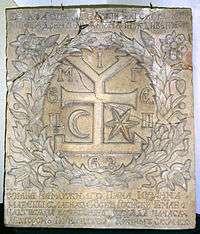
The Great Northern War
In the beginning of the 18th century, as the Russian Empire lost significant territory in the Great Northern War, Peter I decided to reform the Russian army and to centralize control over his realm. In Mazepa's opinion, the strengthening of Russia's central power could put at risk the broad autonomy granted to the Cossack Hetmanate under the Treaty of Pereyaslav in 1654. Attempts to assert control over the Zaporozhian Cossacks included demands of having them fight in any of the tsar's wars, instead of only defending their own land against regional enemies as was agreed to in previous treaties. Now Cossack forces were made to fight in distant wars in Livonia and Lithuania, leaving their own homes unprotected from the Tatars and Poles. Ill equipped and not properly trained to fight on par with the tactics of modern European armies, Cossacks suffered heavy losses and low morale, as their commanders were Russians and Germans who did not value their lives or their specific military abilities . The Hetman himself started to feel his post threatened in the face of increasing calls to replace him with one of the abundant generals of the Russian army.
Change of sides
The last straw in the souring relations with Tsar Peter was his refusal to commit any significant force to defend Ukraine against the Polish King Stanislaus Leszczynski, an ally of Charles XII of Sweden, who threatened to attack the Cossack Hetmanate in 1708. Peter expected that king Charles of Sweden was going to attack and thought that he could spare no forces. In the opinion of Mazepa, this blatantly violated the Treaty of Pereyaslav, since Russia refused to protect Ukraine's territory and left it to fare on its own. As the Swedish and Polish armies advanced towards Ukraine, Mazepa allied himself with them on October 28, 1708. However, only 3,000 Cossacks followed their Hetman, with rest remaining loyal to the Tsar. Mazepa's call to arms was further weakened by the Orthodox Clergy's allegiance for the Tsar. Learning of Mazepa's treason, the Russian army sacked and razed the Cossack Hetmanate capital of Baturyn, killing most of the defending garrison and many common people. The Russian army was ordered to tie up the dead Cossacks to crosses, and float them down the Dnieper River all the way to the Black Sea. This was done for the purpose of intimidating the Mazepa loyalists who lived downstream along the Dnieper.
Those Cossacks who did not side with Mazepa elected a new hetman, Ivan Skoropadsky, on November 11, 1708. The fear of other reprisals and suspicion of Mazepa's newfound Swedish ally prevented most of Ukraine's population from siding with him. Surprisingly, the only significant support which he gathered came from the Zaporizhian Sich, which, though at odds with the Hetman in the past, considered him and the nobility he represented a lesser evil compared with the Tsar. The Sich Cossacks paid dearly for their support of Mazepa, as Peter I ordered the Sich to be razed in 1709 and a decree was issued to execute any active Zaporizhian Cossack.
Decisive battle
The Swedish and Russian armies spent the first half of 1709 maneuvering for advantage in the anticipated great battle, and trying to secure the support of the local populace. Finally in June the Battle of Poltava took place. It was won by Russia, putting an end to Mazepa's hopes of transferring Ukraine into the control of Sweden, which in a treaty had promised independence to Ukraine. Mazepa fled with Charles XII to the Turkish fortress of Bendery, where Mazepa soon died.
Historical legacy
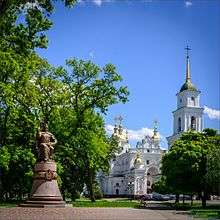
Mazepa's decision to abandon his allegiance to the Russian Empire was considered treason by the Russian Tsar and a violation of the Treaty of Pereyaslav. However others argue that it was Imperial Russia who broke the treaty, because it failed to even try to protect the Cossack homeland during busy fighting abroad while Ukrainian peasants were complaining about the conduct of local Muscovite troops. Many Cossacks had died while building Saint Petersburg and the Tsars planned to deploy Cossack troops far from their homeland.[7][8]
| Part of a series on |
| Cossacks |
|---|
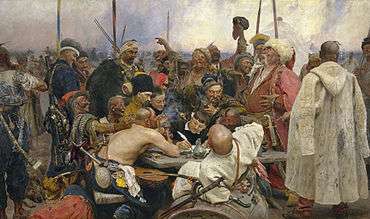 |
| Cossack hosts |
| Other groups |
| History |
| Cossacks |
| Cossack terms |
The image of a disgraceful traitor persisted throughout Russian and Soviet history. The Russian Orthodox Church anathemaised and excommunicated him for political reasons. Until 1869 his name was even added to the list of traitors publicly cursed in Russian churches during the Feast of Orthodoxy service, along with Pugachev, Razin and False Dmitry I. Later on a positive view of Mazepa was taboo in the Soviet Union and considered as a sign of "Ukrainian bourgeois nationalism". During the years of Perestroika, however, many historical works saw light which viewed Mazepa differently. After Ukraine's independence in 1991, Mazepa was proclaimed a national hero in Ukraine's official historiography and mainstream media, because he was the first post-Pereyaslav Treaty hetman to take a stand against the Tsar, who failed to abide the Treaty. This view however is still disputed by pro-Russian factions.[9][10][11] Russia has repeatedly condemned Ukraine for honoring the figure of Ivan Mazepa.[12] According to an April 2009 survey by the Research & Branding Group 30 percent of the population of Ukraine views Mazepa as "a man who fought for the independence of Ukraine", while 28 percent view him "as a turncoat who joined the enemy's ranks".[11]
During an event in Mazepyntsi to mark the 370th birthday (March 20, 2009) of Hetman Mazepa, President Viktor Yushchenko called for the myth about the alleged treason of Mazepa to be dispelled. According to Yushchenko the hetman wanted to create an independent Ukraine and architecture was thriving in Ukraine over the years of Mazepa's rule, "Ukraine was reviving as the country of European cultural traditions".[13] The same day around a hundred people held a protest in Simferopol against the marking of the 370th birthday of Mazepa.[9][10] In May 2009 the Russian foreign ministry stated in an answer to Ukraine's preparations to mark the 300th anniversary of the battle of Poltava and plans to erect a monument to Mazepa that those were attempts at an "artificial, far-fetched confrontation with Russia.[11]

Mazepa's portrait is found on the 10 hryvnia (Ukrainian currency) bill.[11]
After researching his genealogy in 2009 (then) President of Ukraine Viktor Yushchenko did not rule out that his family is connected with the family of Ivan Mazepa.[14]
In August, 2009, a monument to the hetman was unveiled in Chernihiv.[15] The opening was accompanied by clashes between the police and opponents of the Mazepa.[12]
The Ivan Mazepa Street in Kiev, which runs past the Pechersk Lavra, was partly changed to Lavrska Street in July 2010.[16] The move was met with protests.[17]
Late August 2009 Ukrainian President Viktor Yushchenko decreed the resuming of a halted construction of an Ivan Mazepa monument in Poltava.[18] A monument to Mazepa was to be erected on Slava Square in Kiev in 2010 to fulfill a decree of Yushchenko.[19] In May 2010 Kiev city civil servants stated the city was ready to establish a monument as soon as the Cabinet of Ukraine would fund this project.[12] According to them the situation was similar to other unrealised monuments such as the "Unification Monument" and a monument to Pylyp Orlyk who in 2010 were conceived in 2002 and 2003 but still not built in 2010.[12][20] The Poltava City Council on 25 February 2016 voted in favor of the monument.[22] On 6 May 2016 President Petro Poroshenko unveiled the Mazepa monument in Poltava.[23]
Writings
DUMA
(translation by Dimitri Horbay in the newspaper Svoboda March 22, 1958)[24]
While all for peace sincerely preach,
Not all in one direction reach.
Some right, and some left do range,
Yet all are brothers, how very strange.
There is no love, nor does harmony rank
Since we quenched our thirst at the Zhovti's bank.
Through disagreement, non are saved.
By our own endeavor have we become enslaved.
Aye, brothers, 'tis time to see
That we all cannot masters be!
Not all are grace with knowledge wide
Enough, to over all preside.
...
Cultural legacy
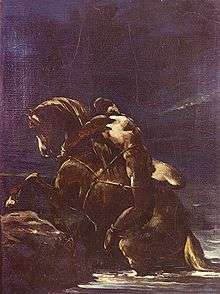
The historical events of Mazepa's life have inspired many literary and musical works:
- Lord Byron – Mazeppa, poem (1818)
- Alexander Pushkin – Poltava, poem (1828–1829)
- Victor Hugo – Mazeppa, poem (1829)
- Juliusz Słowacki – Mazeppa, drama (1840)
- Franz Liszt – Mazeppa, symphonic poem (1851); Transcendental Étude No. 4.
- Pyotr Ilyich Tchaikovsky – Mazeppa, opera (1881–1883)
- Michael William Balfe – The Page, cantata (1861)
- Taras Shevchenko
- Kondraty Ryleyev
- A Ukrainian-language film by Yuri Ilyenko loosely based on historical facts, called Молитва за гетьмана Мазепу (Molytva za hetmana Mazepu) was released in 2002.[25]
See also
Notes
References
- 1 2 Ivan Katchanovski, Zenon E. Kohut, Bohdan Y. Nebesio, Myroslav Yurkevich, Historical Dictionary of Ukraine. Retrieved 10 July 2015
- ↑ ПРО МАЗЕПУ У ВІДНІ (About Mazepa in Vienna). Nataliya Tsirka, Vienna. 2007
- ↑ Ukraine's Navy, despite difficulties, forges ahead with media center by Khristina Lew. The_Ukrainian_Weekly (page 4). January 28, 1996 (English)
- ↑ На Печерську знайдено могилу матері Мазепи (At Pechersk is found a burial of Mazepa's mother). Ukrayinska Pravda
- 1 2 3 4 5 6 7 "Encyclopedia of Ukriane". Encyclopediaofukraine.com. Retrieved 2013-05-08.
- ↑ Hrushevsky, M., page 382.
- ↑ A History of Ukraine, Paul Robert Magocsi, University of Toronto Press, 1996, ISBN 978-0-8020-7820-9, page 244
- ↑ Ukraine: A History by Orest Subtelny, University of Toronto Press, 2000, ISBN 978-0-8020-8390-6, page 164
- 1 2 Events by themes: The mass meeting as token of objecting against celebration in Ukraine of 370th anniversary from the day of birth of Ivan Mazepa, UNIAN-photo service (March 20, 2009)
- 1 2 Opponents to marking 370th birthday of Mazepa rally in Simferopol, Interfax-Ukraine (20 March 2009)
- 1 2 3 4 Swedish king feted in Ukraine 300 years after landmark battle, The Local (June 26, 2009)
- 1 2 3 4 (Ukrainian) В Києві не буде пам’ятника Мазепі The city government is ready to establish a monument, but for this there is neither funding nor of the order of the government, TSN.ua (May 11, 2010)
- ↑ Yuschenko calls for myth of Hetman Mazepa's treason to be dispelled, Interfax-Ukraine (March 20, 2009)
- ↑ Yushchenko researches his genealogy and connects it with family of Ivan Mazepa , UNIAN (December 7, 2009)
- ↑ "Cultural Life/from 'Web site about Ukraine'". Orpheusandlyra.tripod.com. Retrieved 2013-05-08.
- ↑ (Ukrainian) РІШЕННЯ КИЇВСЬКОЇ МІСЬКОЇ РАДИ, Khreshchatyk (September 10, 2010)
- ↑ "Kyivers oppose Ivan Mazepa Street's renaming". Photo.ukrinform.ua. Retrieved 2013-05-08.
- ↑ President demands resuming halted construction of Ivan Mazepa monument in Poltava, Press office of President Victor Yushchenko (August 25, 2009)
- ↑ Monument to Ivan Mazepa to be erected on Slava Square in Kyiv, Interfax-Ukraine (November 19, 2009)
- ↑ The monument to Orlyk was unveiled in June 2011.[21] On 14 October 2015 the Mazepa monument was transported and put on display in Poltava.[22]
- ↑ (Russian) In Kiev, a monument to Philip Orlik, Korrespondent (June 24, 2011)
- 1 2 Poltava: a battle for memory, Den (newspaper), (17 March 2016)
- ↑ (Ukrainian) In Poltava, unveiled a monument to Mazepa, Ukrayinska Pravda (7 May 2016)
- ↑ Svoboda of 1958 (English)/(Ukrainian)
- ↑ Molitva za getmana Mazepu (2002)
Bibliography
- Hrushevsky, M. Illustrated history of Ukraine. "BAO". Donetsk, 2003. ISBN 966-548-571-7
- Orest Subtelny, The Mazepists: Ukrainian Separatism in the Early Eighteenth Century (1981).
- Thomas M. Prymak, "Voltaire on Mazepa and Early Eighteenth Century Ukraine," Canadian Journal of History, XLVII, 2 (2012), 259–83.
- Thomas M. Prymak, "The Cossack Hetman: Ivan Mazepa in History and Legend from Peter to Pushkin," The Historian, LXXVI, 2 (2014), 237–77.
External links
| Wikisource has the text of the 1911 Encyclopædia Britannica article Mazepa-Koledinsky, Ivan Stepanovich. |
- Mazepa article in online at Encyclopedia of Ukraine by Oleksander Ohloblyn
- Ivan Mazepa
- The Name of Ivan Mazepa (in Ukrainian)
- List of churches and monasteries in building of which invested Ivan Mazepa
- Orest Subtelny,"Mazepa, Peter I and the Question of Treason," {http://www.jstor.org/stable/pdfplus/41035779.pdf?acceptTC=true}
- Re-Fighting the Northern War: The Celebration of the Battle of Poltava in Russia. Tatiana Tairova-Yakovleva, Professor, Department of History, St. Petersburg State University. Author: Joseph Dresen (Kennan Institute)
- Stephen Velychenko, "the battle of poltava and the decline of cossack ukraine in light of russian and english methods of rule in their borderlands 1707–1914." {http://historians.in.ua/index.php/doslidzhennya/326-stephen-velychenko-the-battle-of-poltava-and-the-decline-of-cossack-ukraine-in-light-of-russian-and-english-methods-of-rule-in-their-borderlands-1707-1914}